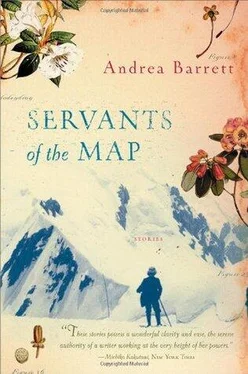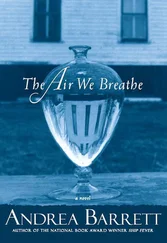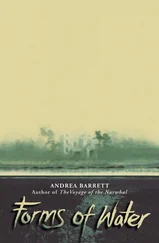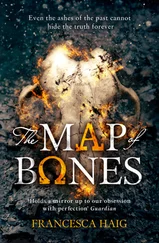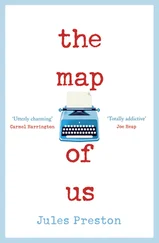The new nurse, she thinks, should be someone younger. Someone vigorous, warm, and good-humored, who can cheer Martin’s last days and counteract her own increasing tendency to worry. Nora grew more relaxed as she aged, gentler, more accepting; she herself is growing fussier, more and more anxious. The tasks that Nora and her friends approached with curiosity, friendship, even joy, have in her, she has thought recently, had a tendency to turn to duties.
But here is her house. Here is her house. Not a duty, but her living self. It is as if, she thinks, as she moves toward Martin and Andrew and all the others up the walk and the clean brick steps, her hand reaching of its own accord for the polished brass knob in the four-paneled door, as if, in the order and precarious harmony of this house and those it shelters she might, for all that gets lost in this life, at last have found a cure.
Although the main characters and situations in these stories are invented, all grew from a foundation in fact. Among the historical characters in the fringes are William Bartram, Charles Darwin, Henry Godwin-Austen, Asa Gray, Joseph Hooker, James Hutton, Charles Lesueur, William Maclure, William Murray, Robert Owen, Rembrandt Peale, Thomas Say, Johann Scheuchzer, John Cleves Symmes, Godfrey Vigne, and William Wells. Excellent guides, every one.
I’m grateful as well to those who guided me to crucial sources and showed me various wonderful stones and bones: Carol Spawn, Ted Daeschler, and Elana Benamy at the Academy of Natural Sciences in Philadelphia, Gary Mason at the Providence Athenaeum, Martha Kelly and Chris Rozzi at Gutenberg Books in Rochester, and Roderic Long of the Sedgwick Museum at the University of Cambridge; also to Philip Gwyn Jones, who brought me to Cambridge and Wales and shared my pleasure in the fossils, Cecile Pickart, who taught me about ubiquitin, Sarah Stone, who gave me the antique Manual of Geography that inspired “Theories of Rain,” and my husband, Barry Goldstein, who introduced me to the Adirondack Mountains and helped me over the glaciers of three countries. The Rochester Public Library, the New York Public Library, and the New York Academy of Medicine provided inspiration as well as information.
The errors and infelicities here are mine, but the book would be much less than it is without the wonderfully insightful readings and helpful comments of my editor, Carol Houck Smith, my agent, Wendy Weil, and my friends and readers, Thomas Mallon and — always, essentially — Margot Livesey.
Andrea Barrettlives in Rochester, New York. As well as Ship Fever — a collection of stories that won the National Book Award for Fiction — she is also the author of five novels, the most recent of which was the much-acclaimed The Voyage of the Narwhal.
Visit www.harpercollins.co.uk for exclusive information on your favorite HarperCollins author.
Praise for Servants of the Map
‘Servants of the Map confirms how deserving Barrett is to be ranked with Alice Munro and the other great North American storytellers of the moment … It is the precision of her words, and the intelligence with which she creates bonds between characters from an age so different from our own, that makes reading her such a joy.’
Economist
A beautifully stylized collection … a testament to the diverse and growing repertoire of an important American writer.’
San Francisco Chronicle
‘The six stories that make up this collection turn out to be connected, but you won’t know exactly how until you read the last one — which comes together satisfyingly not only with its fellows but with the author’s last two books, Ship Fever and The Voyage of the Narwhal … Like fossil-hunters, most of Barrett’s characters are looking for a way to piece together fragments of the past; when, in the last story, a cherished belonging of one character shows up in the life of another, we feel rescued and redeemed.’
New Yorker
‘Breathtaking … Servants of the Map vividly showcases the audacious historical imagination of Andrea Barrett.’
Elle
One of America’s best fiction writers … No one writes about the history of science better than Andrea Barrett.’
Philadelphia Inquirer
‘A lovely collection … Barrett, wise and restrained, can say more about grief in one exchange than many authors can force into an entire book.’
Entertainment Weekly
‘Barrett is a superb storyteller … Her approach is anthropological in the sense that each story background has undergone extensive research which, instead of deadening the impact, gives each a deeper resonance. The main themes are the emotional states of people on scientific or spiritual quests and the distances between people, geographical and emotional in the case of the brilliant title story … Very satisfying.’
Irish Independent
‘Dramatic and profound … Barrett has an uncanny affinity for the nineteenth century … Though she sticks mainly to a decorous prose, she is capable of sudden, startling lyricism … Her ability to navigate the universe’s deepest mysteries with such a gentle touch is a marvel in itself.’
Washington Post
‘Servants of the Map marries arcane science with audacious prose in six gemlike stories that sparkle with intelligence and fire.’
0 Magazine
‘Characterised by a fierce intelligence and an ineffable sense of wonder, and driven by spare, economical prose that, through a mystifying sleight of hand, somehow seems lush, Andrea Barrett’s interwoven tales satisfy completely, utterly. She is surely among the very best writers writing in English today.’
San Diego Tribune
‘Superb … gorgeous, illuminating, entrancing fiction.’
Kirkus Reviews
Portions of this book have appeared previously — sometimes in substantially different form — in the following magazines: “Servants of the Map” in Salmagundi , “The Mysteries of Ubiquitin” in Story, “Theories of Rain” in The Southern Review, “Two Rivers” in Triquarterly, and “The Forest” in Ploughshares. “Servants of the Map” was also included in The Best American Short Stories 2001 and in Prize Stories 2001: The 0. Henry Awards; “Theories of Rain” was included in Prize Stories 2000: The 0. Henry Awards’, and “The Forest” in The 1998 Pushcart Prize XXII. My thanks to these publications and their editors.
Конец ознакомительного отрывка
Купить книгу
